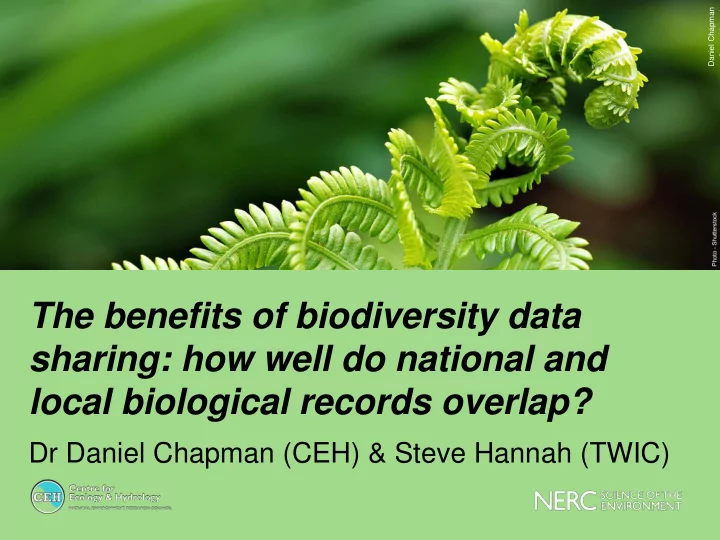

Daniel Chapman Steve Hannah The benefits of biodiversity data sharing: how well do national and local biological records overlap? Dr Daniel Chapman (CEH) & Steve Hannah (TWIC)
Background • Two major sources of UK biological records • National Biodiversity Network (NBN) Partnership of data collectors and users • National coverage • • Local Records Centres (LRCs) Regional coverage • Incomplete coverage in Scotland • Locally tailored data support •
Background • SBIF Action 7: “ Encourage Local Records Centres (LRCs) to carry out a gap analysis on their data holdings and to identify if data available through the NBN Gateway can fill the gaps” • Can NBN and LRCs enhance each others’ data? • What is the potential benefit of data sharing to users?
Overview of our initial study • Focal LRC: The Wildlife Information Centre for the Lothians and Borders (TWIC) • Focal taxa: 66 Habitats Directive taxa occurring in region Annexes 2, 4 & 5 • • Comparison of: Data sources • Temporal overlap • Spatial overlap •
Records used in the study • 14370 from TWIC • 6638 from NBN 224 datasets with records inside TWIC region • Applied for access to all providers • Accessed 55 datasets with Habitats Directive species •
NBN sources for the TWIC region 10 km or better 94% 2 km or better 82% 1 km or better 81% 100 m or better 76% No access 6% 0% 25% 50% 75% 100% % of datasets accessed
NBN and LRC have different data sources NBN TWIC
Why the different data sources? • Lots of TWIC-only data sources are individual recorders Don’t always know if these find their way onto NBN via other • datasets • Some NBN-only sources may only contribute at edge of region e.g. Fife LRC and Natural England • • Some providers give different subsets of their data(sets) to TWIC and NBN May have different names • E.g. BSBI •
Temporal overlap of records NBN has relatively more historical records
Spatial overlap of records • Record density maps for each species • 100 m, 1 km, 2 km, 5 km & 10 km • Measures of overlap between NBN andTWIC • Spearman’s correlation on record density • True Skill Statistic on record presence/absence • Both range from -1 (no overlap) to 1 (perfect overlap)
Example of high overlap ρ = 0.813 TSS = 0.781
Example of low overlap ρ = 0.212 TSS = 0.265
Overlap across the taxa • Overlap is generally quite high but variable • Similar overlap across resolutions (except 100 m)
The potential benefit of greater sharing TWIC would gain 18% more NBN would 10 km grid gain 38% squares more 10 km grid squares NBN TWIC
Conclusions • The LRC and NBN have very different data sources • NBN has more historical records than the LRC • LRC has more individual recorder data
Conclusions • Spatial overlap was variable but quite good • However, more data sharing would provide a major improvement to data quality from both sources • Should benefit all users • Need to understand why data is not shared
Caveats • We couldn’t access all the NBN data • 94% of datasets at 10 km resolution • Only one LRC • May not be representative • Highly non-random selection of species • What about common species or invasives?
Thank you for listening! Acknowledgements: All data providers, Christine Johnston, Ed Mackey, SBIF steering group and members.
Recommend
More recommend